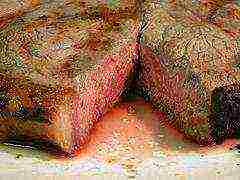Content
 The choice of herbs on the table is a matter of taste. One thing can be said for sure: many people prefer not only parsley, dill and cilantro, but also stalked celery. Caring for him does not differ from caring for other plants in the garden, but the technology of growing in open ground from seeds has some peculiarities. Therefore, in order to obtain an excellent harvest, it is worthwhile to get acquainted with the best varieties - and in the end get the petioles as in the photo in the magazines on agriculture!
The choice of herbs on the table is a matter of taste. One thing can be said for sure: many people prefer not only parsley, dill and cilantro, but also stalked celery. Caring for him does not differ from caring for other plants in the garden, but the technology of growing in open ground from seeds has some peculiarities. Therefore, in order to obtain an excellent harvest, it is worthwhile to get acquainted with the best varieties - and in the end get the petioles as in the photo in the magazines on agriculture!
Briefly about the important, or the absolute benefits of stalked celery
Delicate and languid, slightly sweet, spicy and aromatic, in some varieties a little pungent - this is the taste of celery for those who first tried it. But what is true acquaintance with such a valuable plant? This is not only green twigs similar to parsley and cilantro in salads, pies and stews, not only tubers baked in sour cream with your favorite sauce or pickled root vegetable for meat, but also its middle part, petioles. They are like a bleached false stalk of leeks - delicious and as healthy as possible! Therefore, if you have not tried stalked celery yet, it's time to start.
Celery stalks (as well as leaves and roots) can relieve everyone of:
- extra kg. This is possible due to the high content of dietary fiber, which is not absorbed by the body, but helps to establish the work of the gastrointestinal tract, liver and kidneys, normalize metabolism, strengthen immunity;
- frequent colds, with which a whole vitamin complex will help in the fight - vitamins of groups C, A, E, B;
- ailments of the nervous and cardiovascular systems, since it contains the necessary micro-, macro-elements.
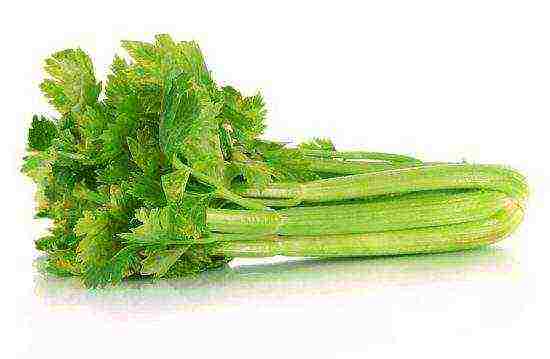
Petiole celery is indispensable in dietary nutrition
In short, there is an obvious benefit of celery in any of its variations. Therefore, attention is paid to the peculiarities of sowing in open ground, competent cultivation to technical ripeness and care!
Attention! Celery is not a panacea for disease! Drinking juices and salads with it should be careful for those who have an ulcer, colitis, kidney stones or gall bladder. The best option is to consult a therapist.
Sowing crops in open ground: stages
Petiole celery gives excellent yields on nutritious soils, in slightly darkened (under the tree) places. He tolerates open sunny areas well, but excessive sun can affect the height of the petiole stem and taste (for example, juiciness). He is not afraid of frost on the ground, so sowing of late varieties can be started already at the end of March in order to collect an excellent harvest by the end of summer and beginning of autumn. The optimum temperature for growing in the open field is + 20C, but it easily transfers "deviations" from performance indicators in one direction or another.
An important feature is soil preparation before sowing seeds in open ground. In depleted areas, the petioles will not be dense and uniform, they will lose their juiciness and aroma characteristic of celery. But every soil can be prepared for sowing. The best time for this is autumn, the period of the first frost. But if you did not know in the fall that you will grow stalked celery in the spring, it doesn’t matter. You can do this in the spring as soon as the ground warms up and you can dig up the desired area.
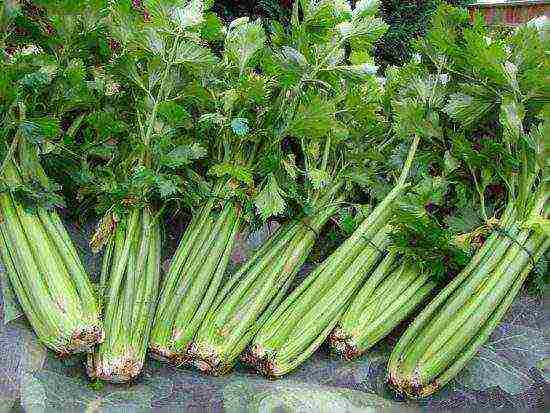
Celery needs nutritious soil
So, the stages of soil preparation for sowing. Necessary:
- Select a site with specific requirements.
- Dig furrows (width - 30-40 cm, depth - 25 cm, on a shovel bayonet).A good solution is 2 furrows side by side - passage - 2 furrows side by side and so on. This arrangement will make it easy to care for the celery and just harvest.
- Fill the furrows with compost, or add peat + sand + humus (1: 1: 0.5), or add superphosphate, mix, cover with earth.
- Before sowing seeds, it is necessary to loosen the ground, get rid of weeds, walk with a rake, and moisten.
- Sow the seeds in the furrows evenly, in one line. The easiest way to do this is by mixing the seeds with sand to distribute them more evenly and to see the planting line and density.
- Sprinkle the seeds with earth, tamp a little.
- Water, cover with spunbond or plastic wrap to create an optimal humidity microclimate.
After that, it is worth watching the shoots that appear on the 5-10th day. The film can be removed to harden the plants, the sprouts under the spunbond can be looked after through the canvas. At the stage of 2-3 natural celery leaves, it is worth thinning out, leaving a distance of 15-20 cm between the plants. Thinned plants can be dived.
When an adult plant reaches a height of 25-30 cm, the rosette of leaves should be tied in order to get even and dense petioles. This is not required for self-bleaching varieties.
Care and features of growing celery stalks, or on the way to large yields
We can say that celery is a culture that is undemanding to grow. Even if you devote a minimal amount of time to grooming, celery will give petioles. Only their height, taste and aroma will be poor. Therefore, a little concern - and everyone will have the opportunity to get a good result!
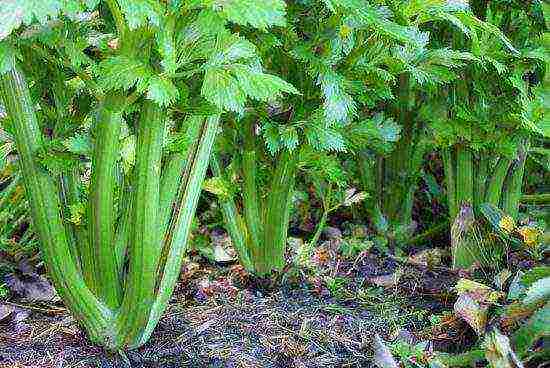
Growing stalked celery
In caring for stalked celery, it is important:
- watering. The plant does not tolerate drought well, so it is worth watering moderately and regularly. Stagnation of water in the garden is not allowed, however, it is better that the root is moistened almost all the time. The upper winding of the soil up to 7 cm is allowed;
- feeding with nitrogen fertilizers up to 4 times per season. In this regard, celery is "gluttonous", responds well to feeding and pleases with the result;
- loosening the soil and removing weeds.
Attention! Growing stalked celery requires hilling! This is necessary so that the petioles are bleached (you can use the old-fashioned method - wrap with paper) and have the maximum height.
The average ripening period for stalked celery is 120-150 days. At the end of the formation of the plant, it can be periodically dug up and eaten. For the winter, the plants need to be dug up together with the root, the root must be slightly peeled, laid horizontally in heating, used as needed.
The best varieties of stalked celery: descriptions
Petiole celery is a culture for the elite, those who bake it, consume it fresh, and also love cocktails. For such gardeners, breeders have bred varieties that delight with good yields, simple care, and frost resistance. Among all the varieties can be distinguished:
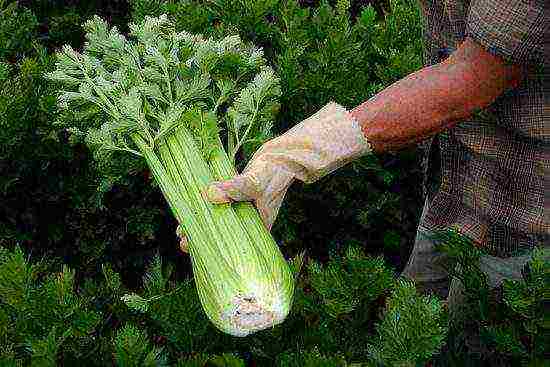
Under suitable conditions, celery can be kept fresh until winter
- Tango late (180 days). It is characterized by an even vertical rosette of leaves, powerful bluish-green petioles. Yieldy, transportable, fragrant;
- Triumph, medium late (130 days). Rosette height of leaves - 65 cm, petioles - 30 cm, color - dark emerald;
- Malachite, early (80 days). The height of the petioles is 20-25 cm, bleached, fleshy and juicy, without veins.
The best option for beginner gardeners is to choose seeds of several varieties, sow, grow stalks and notice the difference. And the next year, give preference to the best variety. There are no particular difficulties in growing stalked celery. The main thing is the choice of the variety, preparation of the soil mixture, hilling. And a great harvest will not be long in coming!
Growing stalked celery: video

In French cuisine, different types of celery are widely used to prepare delicious dishes: mashed potatoes and broths are prepared from root vegetables, stewed in cream, celery stalk is fried, stuffed, added to soups and salads. With Russian housewives, this vegetable plant is not so popular, and if dill is necessarily present in any garden, then celery is found several times less often, although it is not at all difficult to grow it. At the same time, the benefits of celery cannot be overestimated.
Stalked or stalked celery varieties
Petiole and leaf celery varieties are not numerous, but from the available assortment you can choose several varieties that are suitable in taste for growing in a greenhouse, in a pot on a windowsill or in the open field. If you are more interested in root vegetables, check out the popular varieties of root celery in the corresponding article on our website.
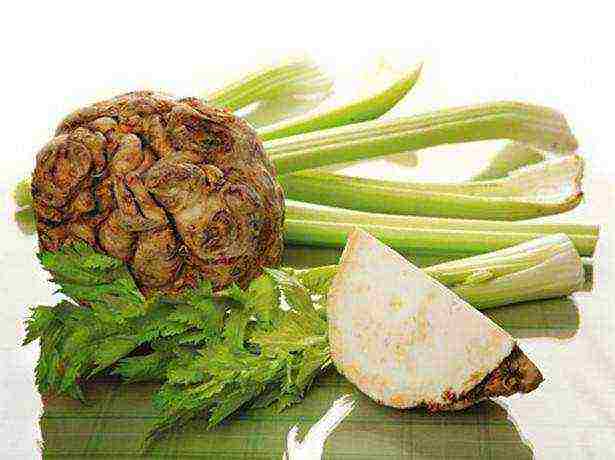
Root varieties have too long growing seasons
You may be wondering: why not plant a root celery in order to immediately get both green foliage and root crops from it? The catch is that root varieties have too long a growing season - you will have to wait a long time for greenery. Even medium early celery Diamant or Apple celery ripen for at least 150 days. In addition, only lateral leaves are allowed to be cut off from root celery, otherwise the root crop will not ripen and remain small. That is why it is better to grow leafy celery varieties on greens, which quickly form a lush rosette with odorous leaves, and to plant petiolate celery to obtain elastic, fleshy stems.
Celery growing video
The cultivation of stalked celery is not very common in our country, therefore, the choice of varieties is small. The main varieties of stalk celery: Utah, Malachite, Triumph, Golden, Pascal, Florida, Tango, as well as the Dutch Loret, Avalon, Daclet, Bolivar, Greenlet.
Malachite
One of the most popular varieties with a growing period of 80 days. In stalked celery Malachite, the leaves are dark green, and the stalks are thick, juicy and fleshy.
Gold
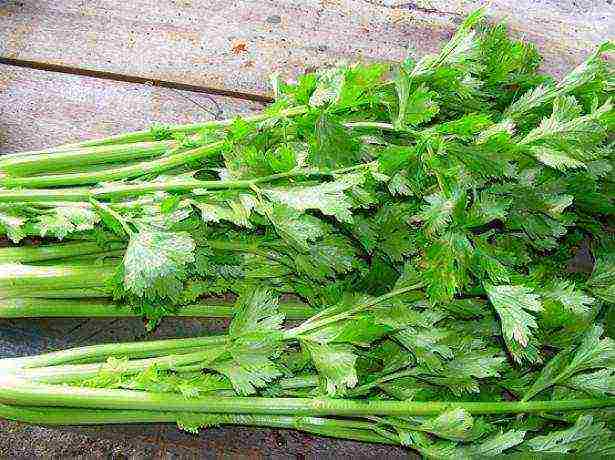
It takes about 150 days before the onset of technical ripeness.
This mid-early variety is grown in order to obtain juicy petioles with excellent taste, not hollow inside. Another advantage of the Zolotoy variety is that it is self-bleaching. It takes about 150 days before the onset of technical ripeness.
Pascal
Celery variety with intense dark green petioles, which reach 22 cm in length. From the appearance of the first shoots to the onset of ripeness, stalk celery of the Pascal variety takes up to 100 days.
Triumph
Stem celery with a growing season of 130 days is classified as a medium late one. Can be used for cultivation in the open field and at home. Celery grows up to 65 cm in height, the rosette turns out to be compact with juicy fleshy stems 30 cm long. The color of the petioles is emerald green.
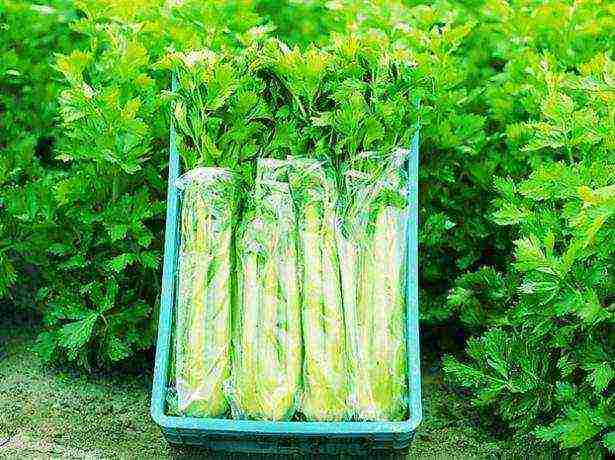
Stem celery with a growing season of 130 days is classified as a medium late
Tango
The petiole Tango variety with a long growing season (up to 180 days) is distinguished by a special bluish-green tint of the stems. In an adult plant, a vertical rosette is formed with long petioles without fibers, curved from the inside. Stem celery of the Tango variety is especially appreciated by vegetable growers for its aroma, excellent taste, the ability to maintain an attractive presentation for a long time and for its high yield.
Leaf celery, popular varieties
Among the varieties of leaf celery cultivated in our country, new successful varieties have appeared relatively recently: Zakhar, Samurai, Nezhny, Athena, Parus.
Cartouli
Recommended for cultivation variety of leaf celery of Georgian selection.The first greens are cut after 65 days from the moment of germination; during the summer, you can cut the growing green mass several more times. The plant has an erect rosette with dark green stems and very fragrant leaves, which are good both fresh and dried. An additional advantage of the Kartuli variety is its resistance to drought and low temperatures.
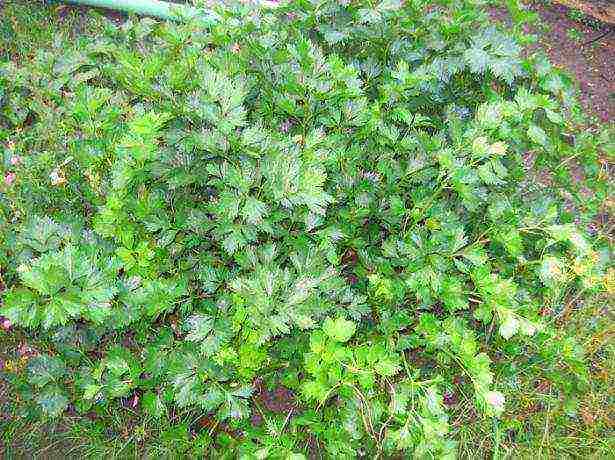
The plant has an erect rosette with dark green stems and very fragrant leaves.
Cheerfulness
The greens of the mid-season variety Vodrost also have a high aromaticity. The growing season of the variety is on average 70 days. Powerful, upright rosettes with highly dissected glossy leaves. Celery variety Bodrost is also not afraid of drought and low temperatures, and greens can be cut several times per season.
Zakhar
The first greens of this mid-season variety can be cut after 105 days, but full technical maturity occurs only 150 days after germination. The yield of green mass is two to three times higher than that of other leafy varieties; after cutting, the greens grow rather quickly. Delicate leaves with medium leaf lobes have a strong pleasant aroma, are well suited for processing, and are widely used fresh.
Video about growing stalked celery
Gentle
A high-yielding, leafy variety of medium ripeness with a growing season of about 100 days. Celery forms a semi-vertical rosette with many lateral shoots. Leaves and petioles are of medium length. Greens are dark in color, medium glossy, very odorous.
Samurai
The peculiarity of the Samurai leaf variety is curly greens, which can be cut off 75 days after germination. On a vertical rosette, reaching a height of 65 cm, long hollow petioles and medium-sized leaves with corrugated edges are formed. The green mass has good taste and strong aroma, is widely used in dried and fresh cooking, and is also suitable for processing.
Rate the article:
(0 votes, average: 0 out of 5)
Petiolate celery - a unique plant. It firmly holds the first place among dietary vegetables in terms of the content of organic acids, vitamins and minerals.
However, the cultivation of stalked celery is not yet a very familiar phenomenon for our summer residents. Leafy celery is common, but this one is just beginning to conquer our gardens. It is sometimes also called stalk celery.
Therefore, we understand from the very beginning - what is stalked celery and how to grow it.
Let's start with the fact that we know perfectly well the celery family ((lat. Apiaceae) - this includes everyone's favorite carrots, as well as parsley, coriander, caraway seeds and parsnips.
The agrotechnology of growing celery with stalks has a lot in common with carrots.
In the first year stalked celery forms dense stems, in the second year - seeds. Its leaves are noticeably larger than those of leafy varieties. The thickness of the petioles is
Its leaves are noticeably larger than those of leafy varieties.
Petioles can be green, pale green, pink and red. The petioles are 8-9 mm thick, 2-3 cm wide, 22-50 cm long. They are. From the emergence of shoots to the cutting of the petioles, 80-180 days pass, depending on the variety. The root system is located at a depth of 20-25 cm.
In the second year of life after planting of mother plants, flower stalks are formed. They bloom in about 2 months. Within 3 weeks, the flowers are pollinated by insects, giving life to the fruit - a small achene. At first it is greenish-crimson, then, when ripe, gray or brownish-brown, splitting into 2 parts. The seeds are very small, in one gram there can be up to 800 pieces. Celery seeds retain their germination capacity for 2-4 years.
All types of celery are easily pollinated among themselves, while their quality deteriorates.For example, petiole stems become hollow and narrow.
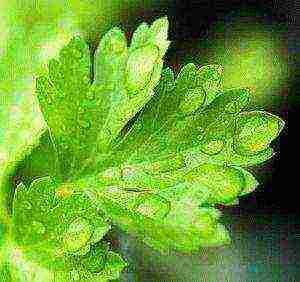 Celery is hygrophilous, but suffers from flooding. In the seedling period, it is responsive to soil and air moisture. Mature plants need abundant watering only during dry periods. For normal development, they need a lot of potassium and nitrogen. Roots need oxygen and, accordingly, frequent loosening of the soil.
Celery is hygrophilous, but suffers from flooding. In the seedling period, it is responsive to soil and air moisture. Mature plants need abundant watering only during dry periods. For normal development, they need a lot of potassium and nitrogen. Roots need oxygen and, accordingly, frequent loosening of the soil.
Petiole celery varieties are divided into green, which need bleaching, and self-bleaching, there are also intermediate forms.
The choice of the method of growing celery (through seedlings or sowing directly into the ground) largely depends on the length of the petiole formation period, so be careful when purchasing seeds.
Self-bleaching celery varieties
Gold... From germination to harvest, 150-160 days pass. Petioles are slightly curved, light green, slightly ribbed, of medium length, rosette weight 830 g, yield up to 5 kg / m2.
Malachite... It takes 80-90 days from germination to harvest. Petioles are thick, fleshy, light green, slightly curved with a slightly ribbed surface, length 30-35 cm, rosette weight 1.2 kg. Productivity 2.8-4 kg / m2.
Tango... One of the best varieties, ready to harvest in 160-180 days. The petiole is up to 50 cm long, bluish-green in color, strongly curved from the inside, without coarse fibers, the weight of the rosette is up to 1 kg. The value of the variety is high aroma, long-term preservation of presentation, good taste. Productivity 1.9-3.7 kg / m2. The variety is resistant to flowers and rust.
Need bleaching
Atlant... From germination to harvesting, 150-170 days pass. Petioles 40-45 cm long, rosette weight 300-340 g. Productivity up to 3.3 kg / m2. ...
Male prowess... A promising variety, ready for harvesting in 150-165 days after germination. Petioles are large, thick, light green, slightly ribbed, slightly curved, length 45-55 cm, rosette weight 560-650 g. Productivity up to 3.3 kg / m2.
Pascal... It takes 100 days from germination to harvest. Petioles are light green, slightly curved, length 25-30 cm, rosette weight up to 450 g. Productivity up to 3.9 kg / m2.
Crunch... Ready for harvesting 100-120 days after germination. Petioles are dark green, fragrant, juicy, of medium length. Productivity 2.9-3.2 kg / m2. The variety is cold-resistant.
Utah... Ready for harvesting 160-180 days after germination. The petioles are powerful, dark green with a violet tinge, curved from the inside, without fibers, weighing 350 g, 25 cm long. Very fragrant, retain their juiciness for a long time. Productivity 3.7 kg / m2.
Celery is an extremely healthy vegetable that is highly regarded by nutritionists. Celery varieties are quite diverse - plants can be root, leaf and petiole.
Varieties of celery
Celery varieties
Root celery is mainly grown in our country. The main value in such plants is the root, but greens are also edible. Petiole celery does not form a large root, but it gives juicy petioles - they are used to prepare salads and other dishes. Celery leafy varieties actively grow greens throughout the season. The leaves are rich in essential oils and vitamins.
Celery varieties by maturity
Root varieties of celery are distinguished by the longest growing season (the root takes from one hundred and fifty to two hundred days to fully ripen). The growing season of leafy varieties takes the least time - already sixty days after the emergence of shoots, you can cut the greens. The middle position is occupied by petioled celery (on average, ripening takes one hundred days). These figures are averaged - the growing season depends on the variety (plants are early, medium and late). The ripening period also depends on the region where the celery is grown.
Popular medium-early and early varieties of root celery: Diamant, Cascade, Yablochny, Gribovsky, Prague giant. Early petiolate and leafy varieties: Golden, Malachite, Parus.
Average ripening times are inherent in the following varieties of root celery: Strong, Albin, Gigant, Egor. Petiole and leafy celery varieties with medium ripening periods: Tango, Spartan, Smurai, Tender, Vigor.
Late root celery varieties are frost-resistant and suitable for winter storage. Here you can distinguish such varieties as Anita and Maxim. Interesting mid-late varieties of petiole and leaf celery are Tiumph and Zakhar.
Celery varieties: recommendations by region
The climate of central Russia is characterized by moderately snowy winters and humid summers. Popular root varieties: Golden Pen, Root Gribovsky, Alabaster, Anita, Yablochny. The most interesting petiole varieties are Atlant and Valet.
The best celery varieties for Siberia and the Urals: Utah, Pascal and Malachite (petiolate), Vodrost, Kartuli and Leaf (leaf), Russian size, Anita, Esaul, Egor, Yablochny, Gribovsky and Silach (root).
Celery variety Anita
Anita is a root variety that is interesting both for central Russia and for Siberia. It has a high yield, can be stored well, tastes good, and is not afraid of frost. Ripening period is medium late. The root crop of this variety is rather large (average weight - 300-400 g). The surface of the root vegetable is grayish white and the middle is white.
The best varieties of root celery
The best varieties are those that have good yields, are not afraid of frost, forming large root crops with a small number of lateral roots. We recommend to opt for such varieties as Russian size, Invictus, Snezhniy ball, Delikates, Zvindra, Prague giant, Alabaster, Esaul, Egor.
Celery variety Albin
The variety Albin is of interest. Ripening period of root crops is average. The variety gives good yields. The rounded root crops reach a diameter of 12 cm. There are very few lateral roots. The pulp is colored white.
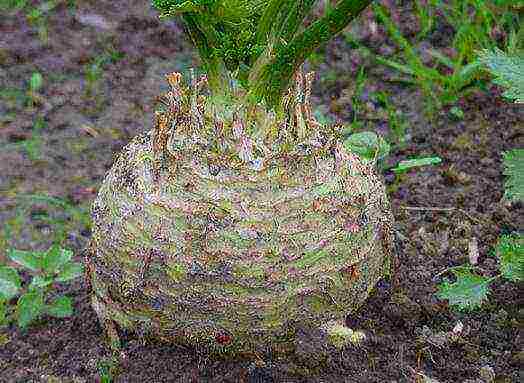
Celery variety Diamant
Celery varieties without lateral roots are Diamant. The growing season takes from 150 to 165 days. The plant has short petioles and large leaves. The mass of root crops reaches 200-300 g. The peel is yellowish-gray, and the pulp is white. The plant is resistant to shooting.
The best varieties of stalked celery
Popular are varieties that are not afraid of frost, have disease resistance, give juicy petioles with good taste. The most popular varieties are Pascal Giant, Golden Pen, Utah, Malachite, Tango, Triumph.
Celery variety Gold
A popular self-bleaching variety of stalked celery is called Golden. It ripens in the mid-early period (the growing season takes 150-160 days). Celery stalks of this variety are quite long, juicy, tasty, dense.
The best varieties of leafy celery
Good leafy varieties of celery are distinguished by abundant greenery and excellent taste characteristics. Here, such varieties as Vodrost, Spartan, Zakhar, Tender, Parus, Samurai, Local, Kartuli, Impruvd Green have proven themselves well.

Celery variety Vigor
The mid-season variety Vodrost reaches technical maturity in 65-70 days. Glossy, highly dissected leaves of this variety have a pleasant aroma. The variety is not afraid of droughts and frosts.
Celery varieties are varied, so it is extremely difficult to single out the best among them. When choosing a variety, it is worth focusing on characteristics that are important in each specific case (for someone it is winter hardiness, for someone a high yield, etc.).

